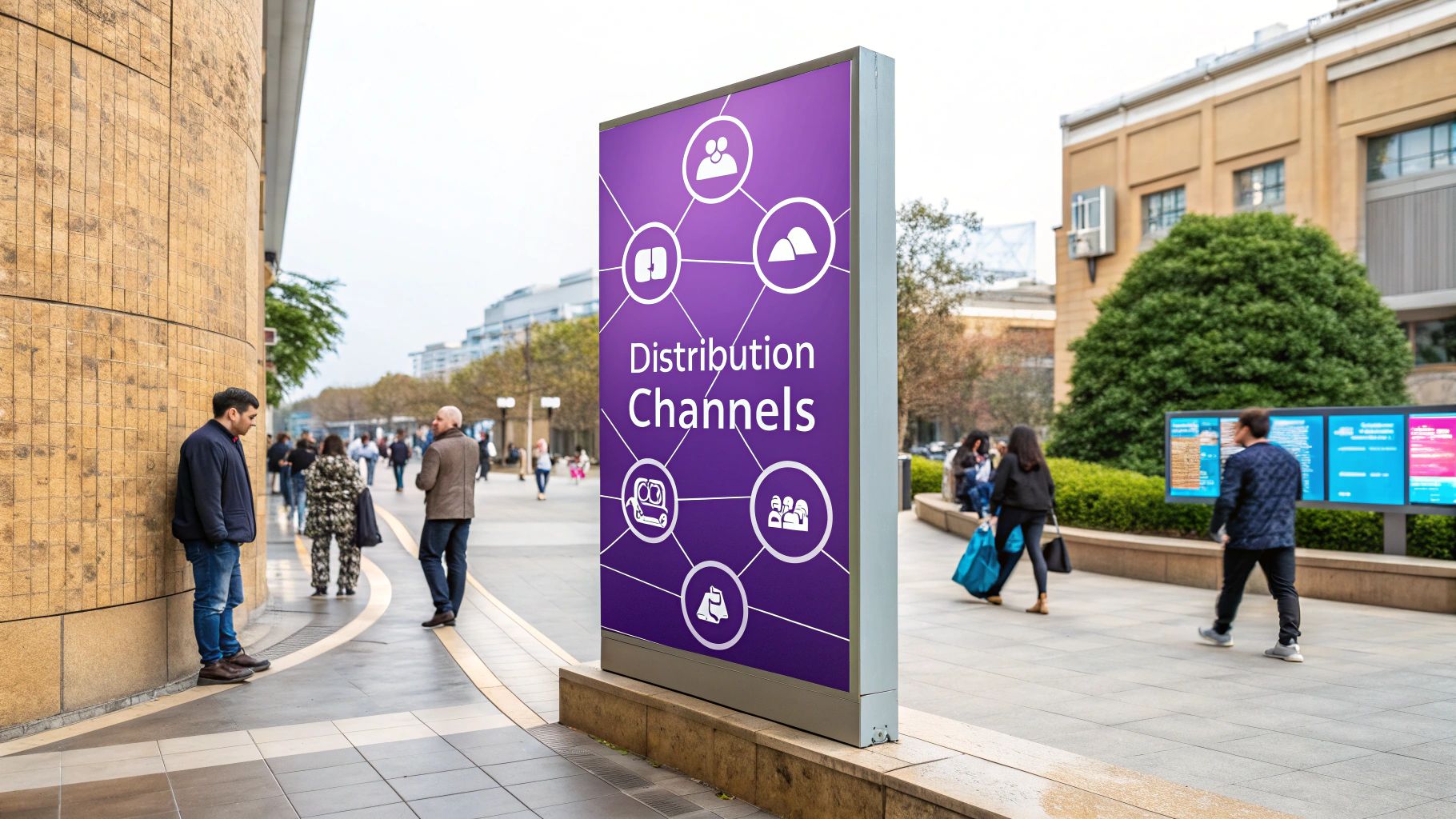content marketing distribution channels: a guide to growth
Think of your content like a killer new product you just invented.You poured your heart and soul into making it perfect. But if it just sits on a shelf in your workshop, unseen and undiscovered, did it ever really exist? Content marketing distribution channels are the delivery trucks, the retail stores, and the word-of-mouth buzz that get your masterpiece into the hands of the people who need it most.
These are the pathways you use to get your articles, videos, and social posts in front of your intended audience. Without them, even the most brilliant content gathers dust.
Why Content Distribution Is Half the Battle
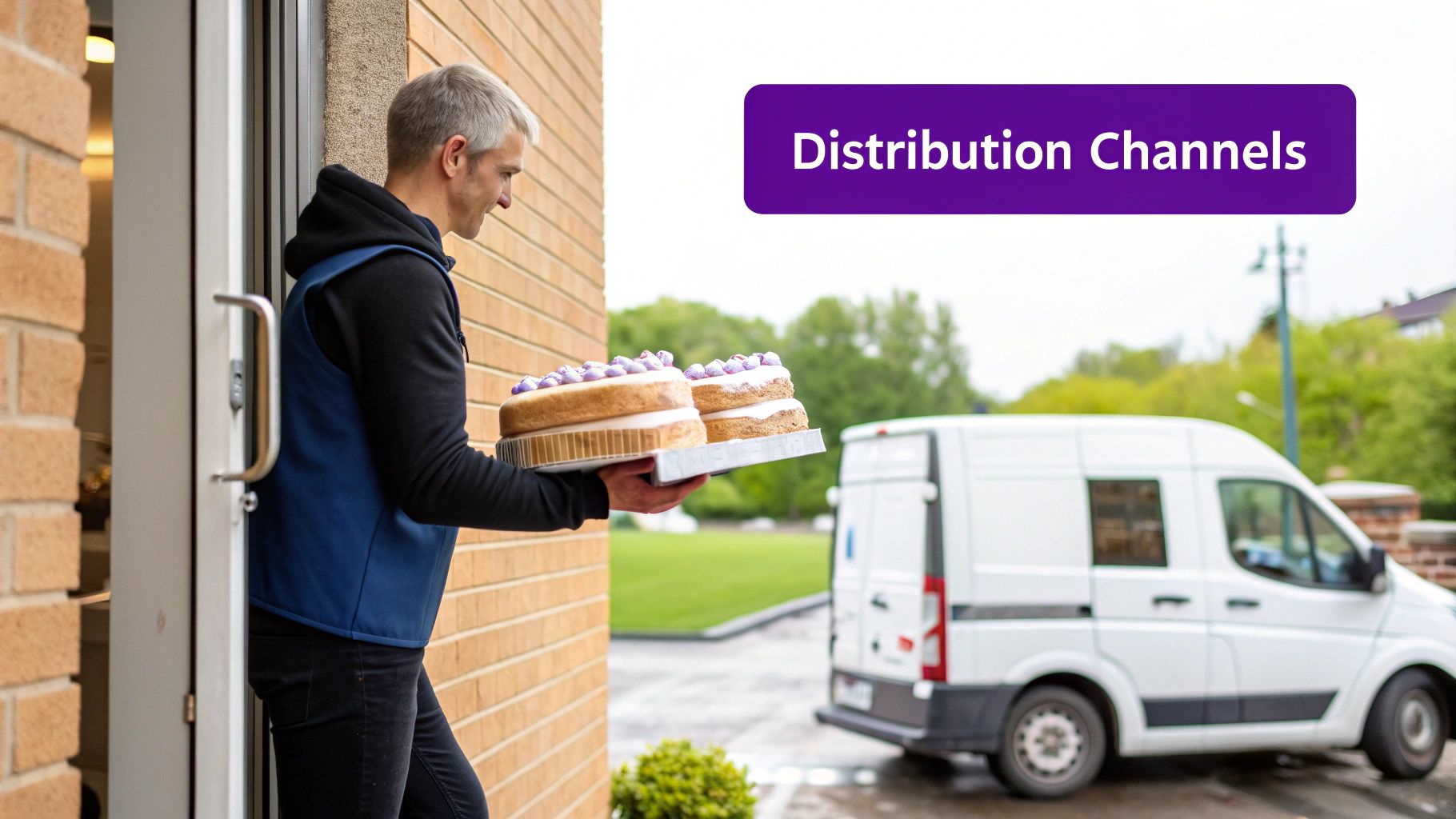
It’s a classic mistake: businesses throw almost all their resources into creating content, then completely forget about how it's actually going to reach anyone. It’s like baking a mind-blowing cake but having no way to get it to the party.
A smart distribution strategy is what turns your content from a lonely asset into a powerhouse marketing tool. It’s how you amplify your message, drive real traffic, and actually start building relationships with potential customers.
The Three Pillars of Content Distribution
When you boil it all down, the entire world of content delivery rests on three core pillars. Getting a handle on these is your first step toward building a strategy that actually moves the needle for your business.
They aren't standalone tactics; they're designed to work together.
- Owned Media: These are the platforms you own and control completely. Think of your website, your blog, your email newsletter, and your brand’s social media profiles. You call all the shots here—the messaging, the timing, and the format—without paying a dime for placement.
- Paid Media: This is when you pay to put your content on the fast track. We're talking about social media ads, search engine marketing (SEM), and sponsored posts. It’s how you guarantee visibility and get in front of a highly specific audience, right now.
- Earned Media: This is the holy grail—the digital version of authentic word-of-mouth. It happens when other people share your stuff organically, like when you get press mentions, guest spots on podcasts, glowing reviews, or unsolicited social media shoutouts. Earned media builds massive credibility because the praise is coming from someone else.
The most successful strategies don't just pick one of these and call it a day. They weave all three together into a powerful system where each channel boosts the others, creating a cohesive multi-channel marketing campaign.
When you see these categories as an interconnected engine, you can build a distribution plan that creates its own momentum, taps into new audiences, and delivers the consistent results you've been looking for.
Building Your Foundation with Owned Media
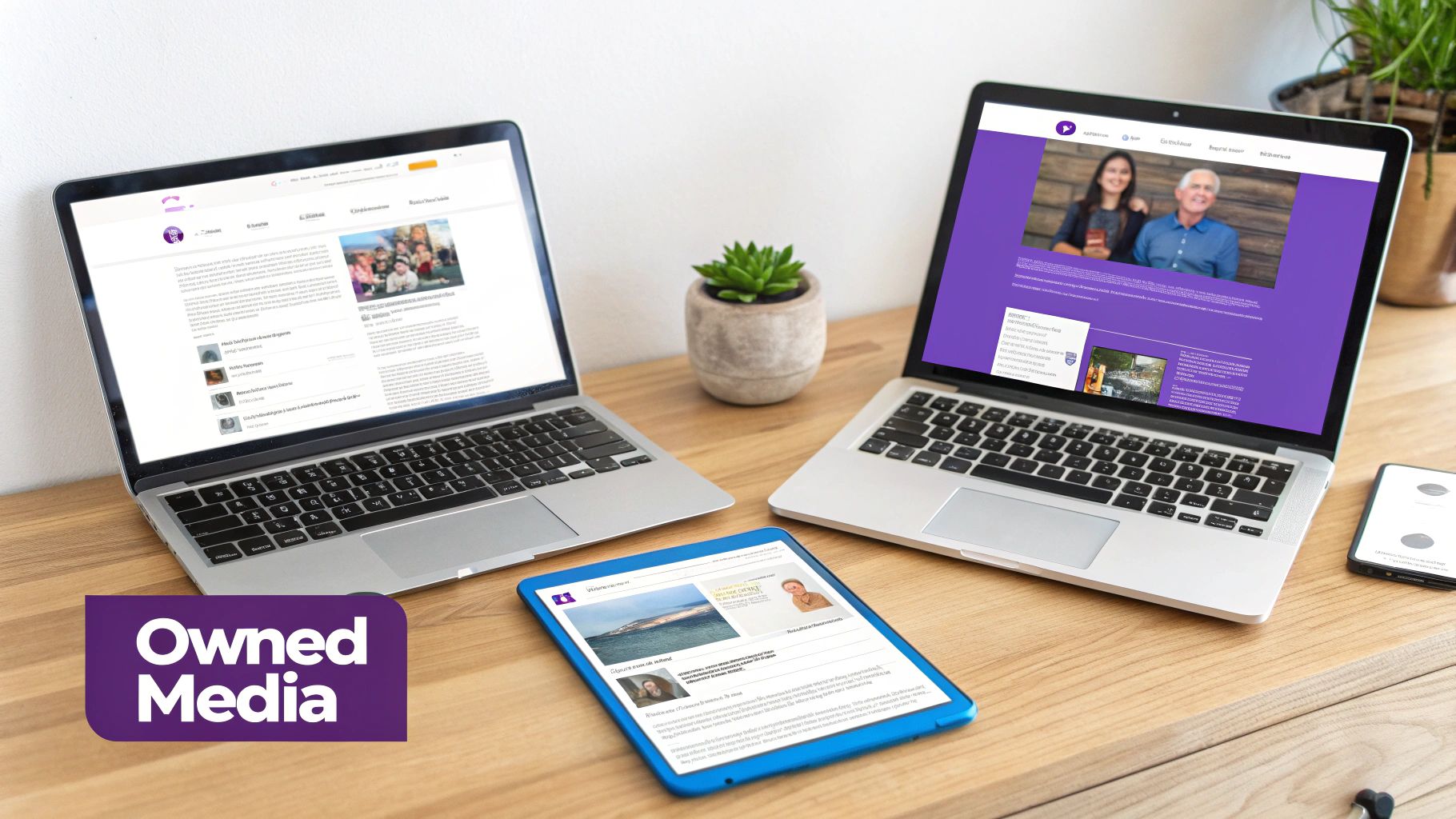
Let’s talk about the real estate you actually own in the digital world. These are your owned media channels—the digital properties you build, manage, and have complete say over.
Think of them as your brand’s home base. It’s the central hub where you write the rules, shape the conversation, and build real relationships with your audience, far from the chaos of someone else’s algorithm.
These assets are the bedrock of any smart content strategy. Every time you hit ‘publish’ on a blog post, send an email, or update your company’s social media profile, you’re operating on your own turf. You control the experience from start to finish.
That direct line to your audience is gold. It’s how you build a community, guide people from curious lurkers to loyal customers, and gather your own data without paying a toll to a tech giant.
Getting the Most Out of Your Core Owned Channels
To really make your owned media work for you, you can't just set it and forget it. Each channel needs its own game plan, but they work best when they’re all talking to each other, creating a reliable system for getting your content in front of the right people.
Here are the primary content marketing distribution channels to nail down first:
- Your Website or Blog: This is where your content lives forever. By optimizing it for search engines (SEO), you turn it into a magnet for organic traffic, pulling in new visitors for months—or even years—after you first publish.
- Email Newsletters: Email is still one of the most direct ways to reach people who actually want to hear from you. Building a subscriber list is like building a dedicated fanbase. If you're starting from scratch, check out our guide on how to build email lists.
- Organic Social Media Profiles: Your social accounts are your outposts. They’re perfect for building a community and sharing your content as it happens, acting like satellites that pull traffic back to your main website.
Owned media is a long game. Unlike a paid ad that disappears the second you stop paying, a killer blog post can pull in organic traffic and generate leads for years. It's an investment that delivers compounding returns over time.
The Power of Owned Media in the Real World
The data doesn’t lie—B2B marketers lean heavily on these foundational channels. A whopping 84% use their blogs and corporate websites to get their content out there, while 71% rely on email newsletters.
And social media? It’s a beast. 89% of B2B marketers use it to share content and connect with their audience. These numbers paint a clear picture: owned media is the central pillar, and social sharing is the amplifier that maximizes its reach.
By consistently creating stuff people actually care about and pushing it out across these channels, you build something priceless: brand equity, trust, and a loyal audience you can talk to directly, whenever you want. This foundation is what makes all your other paid and earned media efforts possible.
Amplifying Your Reach with Paid Media
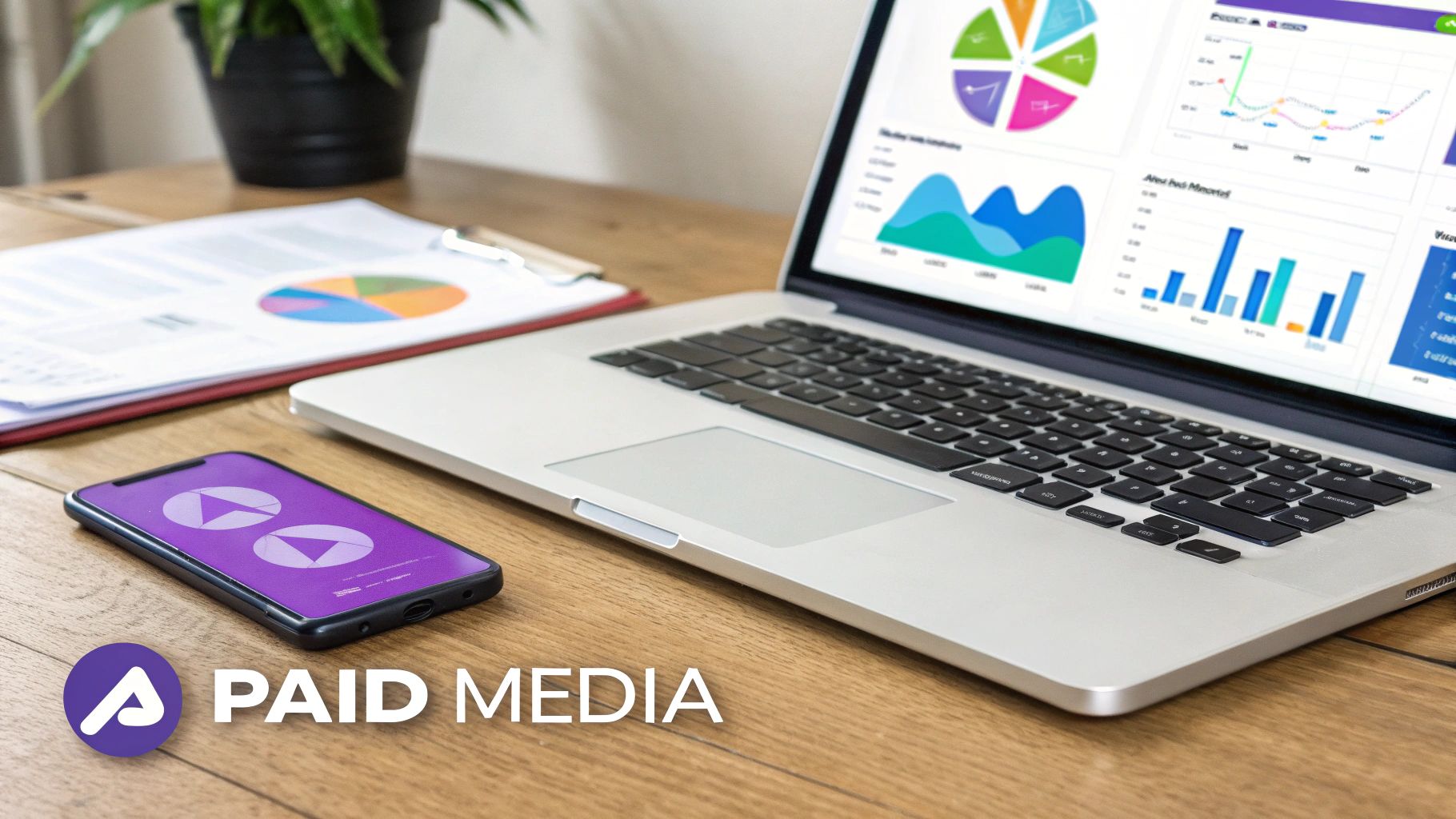
If owned media is your home base, paid media is the megaphone you use to shout from the rooftops. It’s like strapping a rocket booster to your best content and launching it directly in front of the exact people who need to see it, right when they're looking.
This is how you get immediate visibility at a scale that organic efforts just can't touch on their own. It's the perfect play for those high-stakes moments—think a big product launch, promoting a massive cornerstone article, or making a splash in a new market.
Paid distribution isn’t just about "boosting" a post and hoping for the best. It's a surgical investment that, when you get it right, delivers predictable traffic, qualified leads, and results you can actually measure. The game is to stop spending randomly and start running campaigns with data-driven precision.
This surgical approach is more critical than ever. With global digital ad spend projected to smash $740.3 billion by 2025, you're competing in a seriously crowded arena. In fact, about 63% of businesses are already using paid channels to cut through the noise, making it a standard part of any modern marketing playbook.
Key Paid Content Distribution Channels
To run a smart paid strategy, you need to know which tools to pull out of the toolbox and when. Each channel has its own superpowers for hitting specific audiences and nailing different marketing goals.
- Pay-Per-Click (PPC) Advertising: This is your classic Google Ads territory, where your content shows up in search results for specific keywords. It's unbeatable for grabbing the attention of people with high intent—they're literally typing in the problems you solve.
- Social Media Advertising: Platforms like Facebook, Instagram, and LinkedIn offer insanely detailed targeting. You can zero in on users based on their demographics, interests, job titles, and online habits, which is perfect for building brand awareness and scooping up leads. To learn more, check out our guide on the best practices for Facebook ads.
- Sponsored Content & Native Advertising: This is where you pay to feature your article or video on an established publication or an influencer’s platform. You're essentially borrowing their street cred and getting in front of their built-in audience in a way that feels natural, not disruptive.
Making Every Dollar Count
Success with paid media comes down to two things: precision and optimization. Vague targeting and boring creative are just a fast way to burn through your budget. You need a clear, repeatable process that’s obsessed with ROI.
A solid paid campaign always boils down to these three fundamentals:
Laser-Focused Audience Targeting: Know exactly who you're talking to. The tighter your audience segment, the more your message will resonate.
Compelling Creative & Copy: Your ad has to stop the scroll and offer obvious value. A/B test your headlines, images, and calls-to-action to find out what actually works.
Clear Campaign Goals: What's the point of the ad? Are you after website clicks, email sign-ups, or demo requests? Set a clear key performance indicator (KPI) and track it like a hawk.
To make your campaigns even more efficient, you can explore using AI ad generators to help with content creation. Nail these basics, and you'll turn paid media from a line-item expense into a reliable engine for growth.
Earning Trust the Old-Fashioned Way: Earned Media
If owned media is your home base and paid media is the megaphone, then earned media is the standing ovation you get from the crowd. It’s the digital version of pure, unadulterated word-of-mouth—every press feature, social media shoutout, glowing review, and backlink you didn't have to pay for.
This is where the magic really happens. Why? Because it’s not coming from you. When another person, publication, or brand decides your content is worth sharing, they’re putting their own reputation on the line to vouch for you. That third-party stamp of approval is infinitely more powerful to a skeptical audience than any ad you could ever run.
Let’s be clear: earned media isn’t about getting lucky or catching a viral wave. It’s the natural byproduct of a killer strategy. It’s what happens when your owned media is so damn good and your brand experience is so positive that people can't help but talk about you.
Think of it as a force multiplier. It takes all the hard work you poured into your owned and paid channels and launches it into a whole new stratosphere.
How to Get People Talking (Without Paying Them)
So, how do you actually spark this organic buzz? It all starts with creating something that’s genuinely worth talking about. We’re not just talking about informative content; we’re talking about assets that are shockingly insightful, packed with original data, or hit an emotional nerve.
Once you’ve got the goods, the next step is to build real-deal connections in your industry. This isn’t about blasting a press release to a list of 500 reporters. It's about strategic outreach and building relationships.
Here are a few tried-and-true ways to get the earned media ball rolling:
- Good Old-Fashioned PR: Build actual relationships with the journalists and bloggers who cover your space. Don’t just pitch them—offer them unique data, expert commentary, or an exclusive story that will make them look good to their audience.
- Influencer Collaborations: Find the respected voices in your niche—the ones people actually listen to. An endorsement from them can put your brand in front of a dialed-in, ready-to-listen following.
- Outrageously Good Customer Experiences: Create a product or service so exceptional that your customers feel compelled to shout about it. Think glowing reviews on sites like G2, Yelp, or Capterra.
- Guest Posting: Write for other reputable websites in your field. This isn't just an SEO play for backlinks; it’s your chance to plant a flag as a thought leader in front of a brand-new audience.
When you focus on creating undeniable value and fostering genuine relationships, you can systematically earn the kind of media that builds rock-solid brand trust. In the end, this authentic validation is often the final nudge that convinces a potential customer to choose you over everyone else.
Choosing the Right Distribution Channels
A killer content strategy isn't about shouting your message from every rooftop; it's about whispering it in the right person's ear, in the place they already love to hang out. Too many brands take a shotgun approach, spraying their content everywhere and hoping something sticks. That's a great way to burn your budget and your team.
Instead, the real wins come from a tailored plan. Success hinges on three core pillars. Get these right, and you'll stop wasting time on channels that go nowhere and start zeroing in on what actually moves the needle. It's the difference between blindly casting a wide net and using a perfectly baited hook.
The Three Pillars of Channel Selection
Before you spend a single dollar or minute pushing your content live, run every potential channel through this simple but powerful framework. Each pillar forces you to answer a critical question that will guide you to the smartest choices for your brand.
- Your Audience: Where do they actually spend their time online? Are they scrolling LinkedIn for professional hot takes, bingeing TikTok tutorials, or geeking out on niche industry newsletters? Your content has to meet them on their turf, not force them to come find you.
- Your Goals: What are you really trying to do here? A campaign aimed at drumming up immediate leads will lean on different channels (like Google Ads) than one designed to build long-term brand authority (think organic SEO and thought leadership pieces).
- Your Resources: Let’s be real—what’s actually doable for your team and budget? Some channels, like high-production video or intensive paid social campaigns, are resource hogs. Others, like organic social media, demand more time and consistency than cold, hard cash.
Don't just chase the shiny new object. The buzziest channel isn't always the right one for you. A disciplined strategy built on these three pillars will always outperform a plan that just tries to be everywhere at once.
Choosing Your Content Distribution Channels
To make this less abstract, let's map these pillars against some of the most common distribution channels. Think of this table as a cheat sheet for aligning what you want to achieve with the best places to make it happen. It’s all about making sure your content finds the audience it was made for and delivers the results you need.
| Blog/SEO | Brand Awareness, Lead Nurturing | People actively researching solutions | High (Time & Expertise) |
|---|---|---|---|
| Email Newsletter | Customer Retention, Nurturing | Your existing subscribers and loyal fans | Medium (Content & Platform) |
| Paid Search (PPC) | Lead Generation, Conversions | People with high-intent, ready to buy | High (Budget & Management) |
| Paid Social Ads | Brand Awareness, Targeting | Niche demographics and specific interests | Medium-High (Budget & Creative) |
| Organic Social | Community Building, Engagement | Casual scrollers and brand loyalists | Medium (Time & Consistency) |
| Earned Media/PR | Building Credibility, Reach | Audiences who trust third-party validation | High (Time & Relationships) |
Ultimately, the goal isn't just to pick a channel—it's to build a distribution ecosystem. A great blog post (owned) can fuel your email newsletter (owned), get promoted with paid social ads (paid), and hopefully get picked up by an industry publication (earned). When these channels work together, the impact is way bigger than the sum of its parts.
How to Measure Your Distribution Success
Pushing content out into the world without tracking what happens next is like yelling into the void. You hope someone hears you, but you’ll never really know. To turn that guesswork into a repeatable, scalable strategy, you have to track performance across all your content marketing distribution channels.
This is how you validate what’s working, double down on your winners, and stop wasting time and money on channels that just aren’t delivering.
The thing is, each channel type—owned, paid, and earned—tells a different story. You need the right set of KPIs for each one to see the full picture.
Key Metrics for Each Channel Type
When it comes to your owned media—the platforms you control, like your website or email list—your focus should be squarely on audience engagement.
- Organic Traffic: Are people finding you through search? This is your baseline for visibility.
- Time on Page: Once they arrive, are they sticking around to actually read or watch your stuff?
- Email Engagement: What do your open rates, click-through rates, and new subscriber numbers look like? This is your direct line to your most loyal audience.
For paid media, it all comes down to one thing: return on investment. Is the money you're spending actually moving the needle?
- Cost Per Acquisition (CPA): Simple and brutal. How much are you paying to land a new customer?
- Click-Through Rate (CTR): Of all the people who see your ad, what percentage is compelled enough to click?
- Conversion Rates: Are the people who click actually doing the thing you want them to do, like signing up for a demo or making a purchase?
Finally, with earned media, you’re measuring something a bit less tangible but incredibly powerful: influence and social proof. How much are other people talking about you?
A core metric here is Share of Voice, and learning how to calculate Share of Voice is non-negotiable for making smart, data-backed decisions. You’ll also want to track brand mentions, referral traffic from other websites, and the general sentiment around your brand on social media.
Measurement is what turns content distribution from a creative shot in the dark into a predictable business driver. The data doesn't just show you what worked; it gives you the confidence to know where to put your resources for the biggest possible impact.
To help you put this all together, the decision tree below maps out how to pick the right channels based on your audience, goals, and resources.
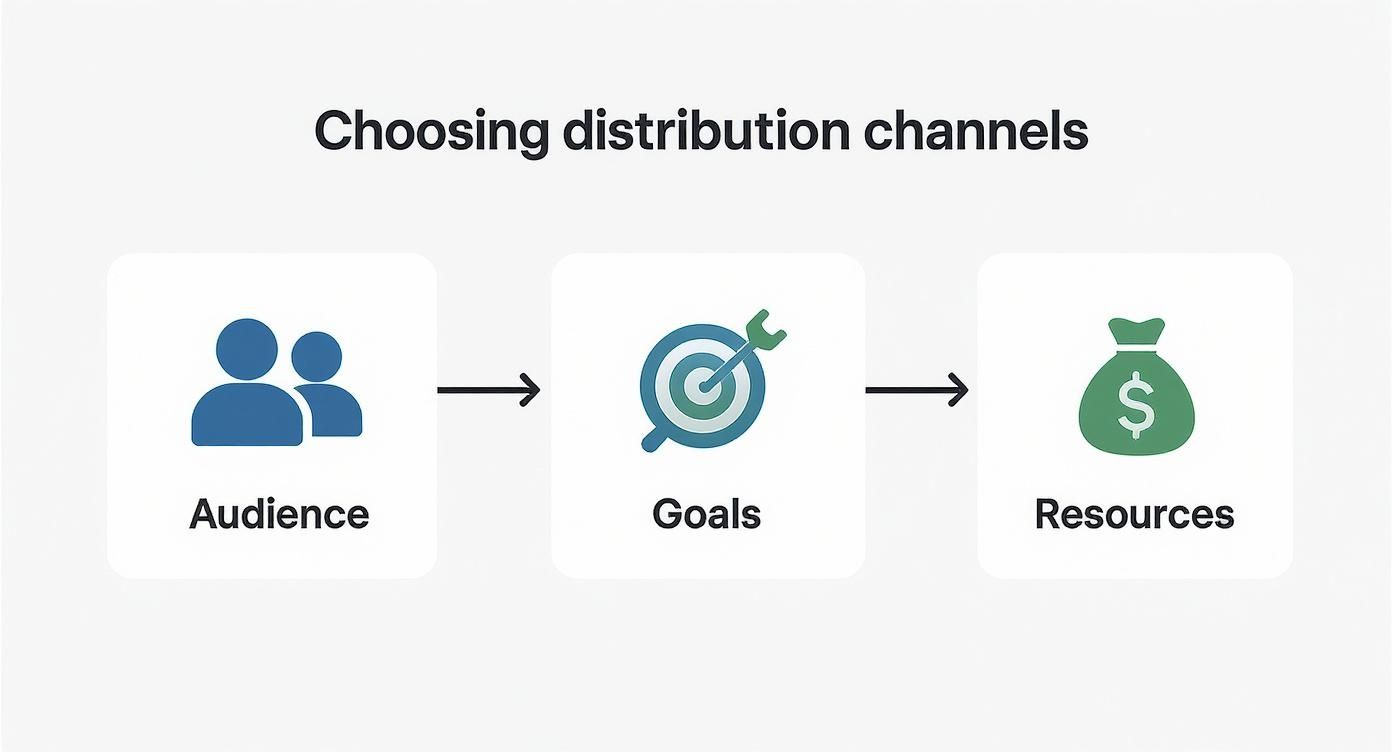
As you can see, it all starts with knowing who you're trying to reach. Get that right, and aligning your goals and resources becomes a whole lot easier.
Got Questions? We've Got Answers
Even with the perfect plan on paper, a few practical questions always pop up when it's time to actually get your content out there. Let's tackle some of the most common hurdles marketers face.
How Should I Budget for Content Distribution?
Ever heard of the 50/50 rule? It’s a game-changer. The idea is simple: you should spend just as much time and money distributing your content as you did creating it.
So, if that killer blog post took you 10 hours to research, write, and design, you should block off another 10 hours just to promote it. This simple mindset shift is the ultimate cure for "create and forget" syndrome, where perfectly good content dies a lonely death on your blog. It forces you to treat distribution as an equal partner in crime.
What Is the Difference Between Content Marketing and Distribution?
Let's break it down with an analogy.
Content marketing is baking a phenomenal cake. You pick the best ingredients (your ideas), follow a killer recipe (your strategy), and create something delicious that people will love.
Content distribution is the delivery driver. It’s the network that gets that amazing cake to the party so people can actually taste it. One creates the value, the other delivers it. You can't have a successful party without both.
How Can I Repurpose One Piece of Content for Multiple Channels?
This is where the pros separate themselves from the amateurs. The goal is to get the most mileage out of every single piece of content you create. You can "atomize" a big asset into dozens of smaller pieces, each perfectly suited for a different channel.
Repurposing isn't just copy-pasting. It’s about translating your core message into the native language of each platform. A single blog post can become a content engine that runs for weeks.
For example, take one of your long-form blog posts and spin it into gold:
- Social Media Snippets: Pull out the punchiest quotes, stats, or takeaways for Twitter or LinkedIn posts.
- An Infographic: Turn the key data points or steps into a visually slick graphic for Pinterest or to break up the blog post itself.
- A Short Video Script: Convert the main sections into a quick, snappy script for an explainer video on YouTube Shorts or Instagram Reels.
This approach doesn't just save time; it multiplies the impact of your original effort, reaching new audiences in the formats they prefer.
Ready to build a distribution strategy that actually moves the needle? At Rebus, we create and execute data-driven campaigns that get your content in front of the right audience, every time. See how we can help you grow.
